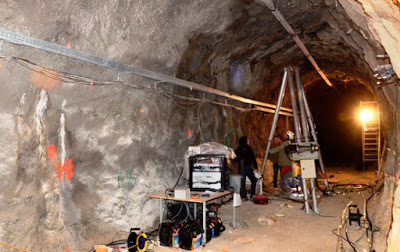
Injecting water into a geological fault causes the rock to move harmlessly for a short time before it slips enough to produce an earthquake, a study shows. The discovery suggests that energy companies might be able to control the start of the earthquakes that they sometimes trigger as they inject fluids into the ground during oil, gas or geothermal exploration.
To test how fluid injections affect seismic activity, geologists squirted water 282 metres deep into rocks at an underground laboratory in southeastern France. They measured, more carefully than ever before, exactly how the ground shifted as the fluid coursed through it.
For the first several minutes, the ground moved quietly, with no earthquakes. “Only after a while do you see some seismicity occurring,” says team leader Yves Guglielmi, a geologist at the University of Aix-Marseille in France, whose findings are published in Science.
Pumping fluid into the ground can trigger earthquakes by unclamping the stresses that hold the sides of a geological fault together. The extra fluid relieves those stresses and allows the rock to shift.
Researchers have understood the basics of this phenomenon since the late 1960s and early 1970s, when the US Geological Survey counted the earthquakes set off as operators injected fluids down an industrial well. But Guglielmi’s team went further by carefully controlling and measuring the whole process from start to finish.
Slip and slide
The researchers developed a cylindrical probe that can record precisely how a fault moves in all three dimensions, while monitoring fluid pressure. They lowered the instrument into a borehole that penetrates a fault in limestone rocks at the Low-Noise Underground Laboratory in Rustrel, France.
Over a half an hour, the scientists injected a total of 950 litres of water into the fault, at rates comparable to industrial injections. During the first part of the test injection, the rocks crept along without generating any earthquakes. Then they began to move faster, and small earthquakes began to break out. By the time the researchers turned off the water, one rock face in the fault had moved a little more than 1 millimetre past the other. “The experiment is quite tiny,” says Guglielmi.
If operators of commercial wells can monitor their equipment as carefully as the research team did, they might be able to control how much the ground slips by adjusting the rate of fluid injection, says François Cornet, a geophysicist at the University of Strasbourg in France. In 2009, a geothermal project in Basel, Switzerland, was shut down because of the risk of triggering earthquakes. In Oklahoma, oil and gas operators are facing a huge public backlash because of a rash of small earthquakes that have been rattling the region, almost certainly linked to wells that inject waste water deep into the underlying rocks.
Cornet warns that the discovery applies to only one particular hole, and that it might not hold up in areas with different geology. Still, in 1993, he and his colleagues injected large amounts of water down a geothermal well in northeastern France, and measured what could have been the same sort of non-earthquake slip as pressure built up along the fault.
Guglielmi says that his team has already run tests at a second borehole drilled into shale, with similar results.
Note : The above story is based on materials provided by Nature. The original article was written by Alexandra Witze.










